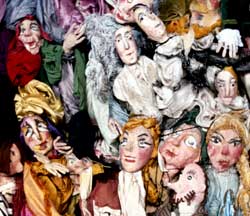
 Collezione
Maria Signorelli
Collezione
Maria Signorelli
Podrecca Fund
(string puppets, sets, set designs, documentation)
The
Puppets of Maria Signorelli
The fairy tales, nursery rhymes and films
Shows with classical and modern texts, films
The ballets of Maria Signorelli
Podrecca Fund
19th-20th century Italian rod and glove puppets
19th-20th century Italian marionettes
20th century foreign rod and string puppets
Sicilian, Pugliese and Neapolitan puppets
Toy
rod, glove and string puppets
Paper
and card theatres, sets and characters
Scripts
of puppet and marionette plays
Posters
of puppet theatre productions and festivals
The Fund belonged to the Compagnia dei Piccoli of Vittorio Podrecca
(1883-1959), one of the legends of twentieth-century Italian theatre. Created in Rome on the eve of the First World War, from 1914 to
1966, therefore even after the death of its creator, this puppet company was famed in Italy and beyond for its great artistic talents
and technical skills. Its miniature theatre performed classical and twentieth-century musical works, was sought after by first-rank
impresarios and financed by patrons such as Arturo Toscanini, who were firm believers in the artistic value of its productions.
The Podrecca Fund comprises 158 puppets in excellent condition, with very accurate and beautifully made clothes and accessories.
Many are from famous works, such as Paisiello’s The Barber of Seville, Puss in Boots, Mozart’s Don Giovanni, Verne’s Twenty Thousand Leagues under the Sea, Bottesini’s Ali Baba, Collodi’s Pinocchio, together with huge casts for the brilliant Varietà or Vaudeville, the most famous show in the Piccoli’s repertoire.
The majority are between eighty centimetres and one metre tall, but with widely varying characteristics.
Some have a very expressive face, carved with great mastery: for example the monks in the Forza del Destino, Captain Fracasse in the Carnival of Venice, the Boxers in Cack Cascan, the latter probably created by the Gorno Dall’Acqua family in the 1920s. Others, such as those for Le Maschere Italiane (The Italian Masks), are painted and costumed with great sophistication. There are even some constructed of soft felt, such as the characters in the Cavallino Bianco (Little White Horse), created in Brazil.
The Fund also contains around 30 unclothed or semiclothed puppets, and a certain number of clothes, shoes, hats and wooden control bars for the strings. There are also 48 front curtains, proscenium frames and backcloths (on average over two metres high and between five and six and a half metres wide, most in good condition, among them: five for La Boite à joujoux, five for Twenty Thousand Leagues under the Sea, three for Genoveffa di Brabante, two for The Thieving Magpie, two for Cinderella, two for Don Giovanni, two for Pinocchio, two for Fortunello, two for Ali Baba, one for Peter and the Wolf.
Some are backcloths for ‘numbers’ included in one of the many editions of the Varietà, for example, The Boxing Match, The Geisha Girls, The Three Thieves in the Cage, ‘numbers’ which because of their great effect, had been taken from other works for which they had been originally created. Other backcloths were used for shows performed in South America, among them three for Brazil, the two for Colmao (a type of show consisting solely of Spanish numbers) and then those for Rumba, Criolita and Argentin.
Others again have ‘comodino’ written on
the back of them: these are little curtains that could be lowered at certain moments in the performance, to allow a scene change to take
place behind them while the action on stage continued.
In addition there are around one hundred set designs by various artists, including Bruno Angoletta (for productions such as Guerrin Meschino, The Tempest, The Sleeping Beauty and Don Giovanni), Duilio Cambellotti (Il diluvio universale [The Flood]), Caramba (The Thieving Magpie), Giuseppe Cominetti (Ciottolino), Marco Montedoro (Giovanni di Parigi and Ali Baba), Mario Pompei (The Elixir of Love, The Marriage Contract, Betly or the Swiss Chalet, White and Black, The Barber of Seville, The Heart of Colombina, The Thieving Magpie, Little Red Riding Hood), Gino Carlo Sensani (The Love for Three Oranges) and Sergio Tofano for The Two Suitors of 1923.
In the collection there are also ten boxes containing copious documentation
relating to the entire performing history of the company (programmes, playbills, publicity leaflets, scripts and music scores that allow
a reconstruction of the changes undergone in the repertoire over the years; various documents such as letters and account books) and,
finally, a large number of photographs of puppets, theatres, well-known figures in the world of the theatre and of the arts
such as Gabriele d’Annunzio, Maurice Chevalier, Josephine Baker, and also Benito Mussolini.
A selection from the Fund was included in the exhibition La Fabbrica dei Sogni - la compagnia dei Piccoli di
Podrecca 1914-1959 - marionette e materiali scenici della Collezione Signorelli (The Factory of Dreams - the Compagnia dei Piccoli of
Podrecca 1914-1959 - puppets and scenery from the Signorelli Collection) organised by Patrizia Veroli and Giuseppina Volpicelli and
mounted in the Casa dei Teatri di Roma from 11 November 2005 to 11 February 2006, catalogue published by Bora Bologna with texts by
Paolo Campanini, Grazia della Valle, Ezio Flammia, Marino Jerman, Paola Pallotino, Didier Plassard, Vincenzo Recchia, Patrizia Veroli
and Giuseppina Volpicelli.
